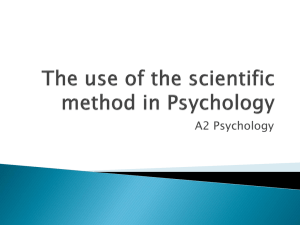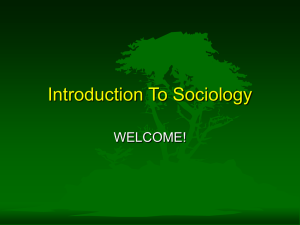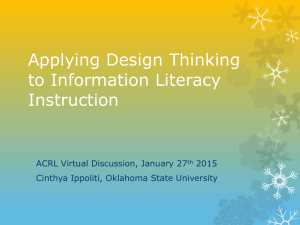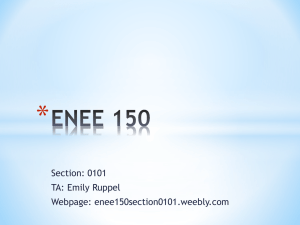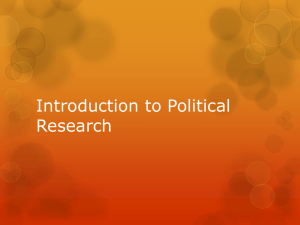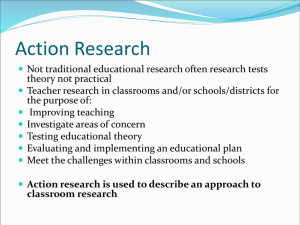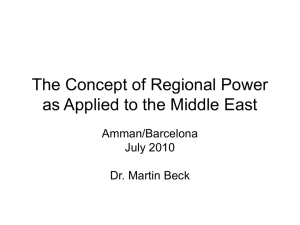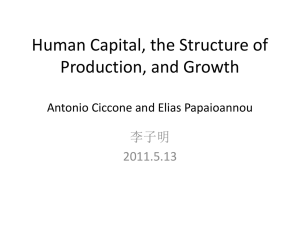Research Goal
advertisement
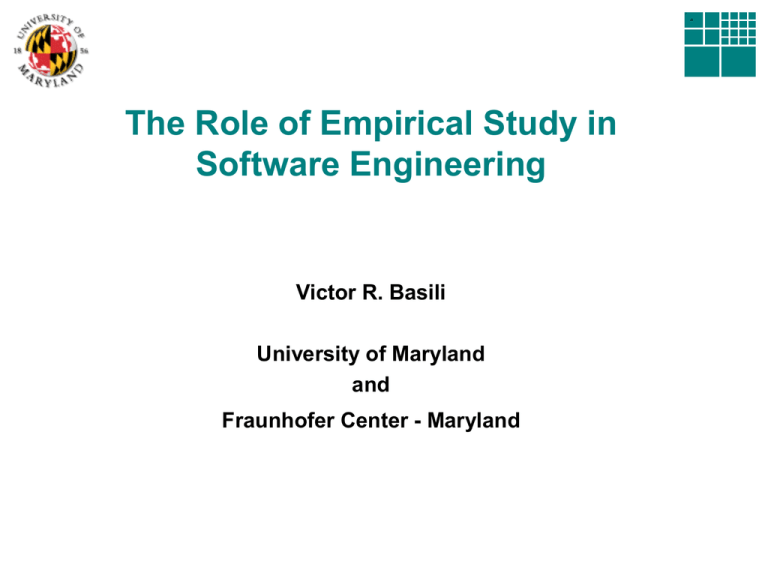
The Role of Empirical Study in Software Engineering Victor R. Basili University of Maryland and Fraunhofer Center - Maryland Outline • Empirical Studies – Motivation – Specific Methods – Example: SEL • Applications – CeBASE – NASA High Dependability Computing Project – The High Productivity Computing Systems Project – Acquisition Best Practices Project 2 Motivation for Empirical Software Engineering Understanding a discipline involves building models, e.g., application domain, problem solving processes And checking our understanding is correct, e.g., testing our models, experimenting in the real world Analyzing the results involves learning, the encapsulation of knowledge and the ability to change or refine our models over time The understanding of a discipline evolves over time This is the empirical paradigm that has been used in many fields, e.g., physics, medicine, manufacturing Like other disciplines, software engineering requires an empirical paradigm 3 Motivation for Empirical Software Engineering Empirical software engineering requires the scientific use of quantitative and qualitative data to understand and improve the software product, software development process and software management It requires real world laboratories Research needs laboratories to observe & manipulate the variables - they only exist where developers build software systems Development needs to understand how to build systems better - research can provide models to help Research and Development have a symbiotic relationship requires a working relationship between industry and academe 4 Motivation for Empirical Software Engineering For example, a software organization needs to ask: What is the right combination of technical and managerial solutions? What are the right set of process for that business? How are they tailored? How do they learn from their successes and failures? How do the demonstrate sustained, measurable improvement? More specifically: When are peer reviews more effective than functional testing? When is an agile method appropriate? When do I buy rather than make my software product elements? 5 Examples of Useful Empirical Results “Under specified conditions, …” Technique Selection Guidance • Peer reviews are more effective than functional testing for faults of omission and incorrect specification (UMD, USC) • Functional testing is more effective than reviews for faults concerning numerical approximations and control flow (UMD, USC) Technique Definition Guidance • For a reviewer with an average experience level, a procedural approach to defect detection is more effective than a less procedural one. (UMD) • Procedural inspections, based upon specific goals, will find defects related to those goals, so inspections can be customized. (UMD) • Readers of a software artifact are more effective in uncovering defects when each uses a different and specific focus. (UMD) 6 What do I believe? • Software engineering is an engineering discipline • We need to understand products, processes, and the relationship between them (we assume there is one) • We need to experiment (human-based studies), analyze, and synthesize that knowledge • We need to package (model) that knowledge for use and evolution • Believing this changes how we think, what we do, what is important 7 What do I believe? • Measurement is fundamental to any engineering science • User needs must be made explicit (measurable models) • Organizations have different characteristics, goals, cultures; stakeholders have different needs • Process is a variable and needs to be selected and tailored to solve the problem at hand • We need to learn from our experiences, build software core competencies • Interaction with various industrial, government and academic organizations is important to understand the problems • To expand the potential competencies, we must partner 8 Basic Concepts for Empirical Software Engineering The following concepts have been applied in a number of organizations Quality Improvement Paradigm (QIP) An evolutionary learning paradigm tailored for the software business Goal/Question/Metric Paradigm (GQM) An approach for establishing project and corporate goals and a mechanism for measuring against those goals Experience Factory (EF) An organizational approach for building software competencies and supplying them to projects 9 Quality Improvement Paradigm Package & store experience Corporate learning Set goals Analyze results Execute process Project learning Characterize & understand Provide process with feedback Choose processes, methods, techniques, and tools Analyze results 10 The Experience Factory Organization Project Organization 1. Characterize 2. Set Goals 3. Choose Process Execution plans 4. Execute Process Experience Factory environment characteristics tailorable knowledge, consulting Project Support Generalize products, lessons learned, models project analysis, process modification 6. Package Tailor Experience Base Formalize Disseminate 5. Analyze data, lessons learned 11 The Experience Factory Organization A Different Paradigm Project Organization Problem Solving Experience Factory Experience Packaging Decomposition of a problem into simpler ones Unification of different solutions and re-definition of the problem Instantiation Generalization, Formalization Design/Implementation process Analysis/Synthesis process Validation and Verification Experimentation Product Delivery within Schedule and Cost Experience / Recommendations Delivery to Project 12 SEL: An Example Experience Factory Structure PO EF PROCESS ANALYSTS DEVELOPERS (PACKAGE EXPERIENCE FOR REUSE) (SOURCE OF EXPERIENCE) STAFF STAFF 275-300 developers Development FUNCTION measures for each project TYPICAL PROJECT SIZE 100-300 KSLOC ACTIVE PROJECTS 6-10 (at any given time) PROJECT STAFF SIZE 5-25 people TOTAL PROJECTS (1976-1994) 120 10-15 Analysts • Set goals/questions/metrics - Design studies/experiments • Analysis/Research Refinements to development process • Refine software process - Produce reports/findings PRODUCTS (1976-1994) NASA + CSC 300 reports/documents NASA + CSC + U of MD DATA BASE SUPPORT (MAINTAIN/QA EXPERIENCE INFORMATION) STAFF 3-6 support staff SEL DATA BASE 160 MB FORMS LIBRARY 220,000 REPORTS LIBRARY • SEL reports • Project documents • Reference papers FUNCTION • Process forms/data • QA all data • Record/archive data • Maintain SEL data base • Operate SEL library NASA + CSC 13 Using Baselines to Show Improvement 1987 vs. 1991 vs. 1995 Continuous Improvement in the SEL Decreased Development Defect rates by 75% (87 - 91) 37% (91 - 95) Reduced Cost by 55% (87 - 91) 42% (91 - 95) Improved Reuse by 300% (87 - 91) 8% (91 - 95) Increased Functionality five-fold (76 - 92) CSC officially assessed as CMM level 5 and ISO certified (1998), starting with SEL organizational elements and activities Fraunhofer Center for Experimental Software Engineering - 1998 CeBASE Center for Empirically-based Software Engineering - 2000 14 CeBASE Center for Empirically Based Software Engineering CeBASE Project Goal: Enable a decision framework and experience base that forms a basis and infrastructure needed to evaluate and choose among software development technologies CeBASE Research Goal: Create and evolve an empirical research engine for building the research methods that can provide the empirical evidence of what works and when 15 CeBASE Approach Observation and Evaluation Studies of Development Technologies and Techniques Empirical Data Predictive Models General Heuristics (Quantitative Guidance) (Qualitative Guidance) E.g. COCOTS excerpt: E.g. Defect Reduction Heuristic: Cost of COTS tailoring = f(# parameters initialized, complexity of script writing, security/access requirements, …) For faults of omission and incorrect specification, peer reviews are more effective than functional testing. 16 CeBASE Three-Tiered Empirical Research Strategy Technology maturity Primary activities Evolving results Practical applications (Government, industry, academia) Practitioner tailoring, usage of, and feedback on maturing ePackage. Increasing success rates in developing agile, dependable, scalable IP applications. Applied Research Exploratory use of evolving ePackage. Experimentation and analysis in selected areas. More mature, powerful ePackage. Faster technology maturation and transition. Explore, understand, evolve nature and structure of ePackage. Evolving ePackage understanding and capabilities. (e.g. NASA HDCP) Basic Research (ePackage = Empirical Research Engine, eBase, empirical decision framework) 17 CeBASE Basic Research Activities Define and improve methods to • Formulate evolving hypotheses regarding software development decisions • Collect empirical data and experiences • Record influencing variables • Build models (Lessons learned, heuristics/patterns, decision support frameworks, quantitative models and tools) • Integrate models into a framework • Testing hypotheses by application 18 NASA High Dependability Computing Program Project Goal: Increase the ability of NASA to engineer highly dependable software systems via the development of new techniques and technologies Research Goal: Quantitatively define dependability, develop high dependability technologies and assess their effectiveness under varying conditions and transfer them into practice Partners: NASA, CMU, MIT, UMD, USC, U. Washington, Fraunhofer-MD 19 Main Questions How can I understand the stakeholders quality needs? System Developers How can I apply the available processes to deliver the required quality? Experience Base 20 What are the top level research problems? System Users Failures Space Research Problem 3 What set of processes should be applied to achieve the desired quality? (Decision Support) Research Problem 1 Can the quality needs be understood and modeled? (Product Models) Process Developers Fault Space System Developers Research Problem 2 What does a process do? Can it be empirically demonstrated? 21 System User Issues How do I elicit quality requirements? How do I express them in a consistent, compatible way? • How do I identify the non-functional requirements in a consistent way? – Across multiple stakeholders – In a common terminology (Failure focused) – Able to be integrated • How can I take advantage of previous knowledge about failures relative to system functions, models and measures, reactions to failures? – Build an experience base • How do I identify incompatibilities in my non-functional requirements for this particular project? 22 UMD - Unified Model of Dependability • The Unified Model of Dependability is a requirements engineering framework for eliciting and modeling quality requirements • Requirements are expressed by specifying the actual issue (failure and/or hazard), or class of issues, that should not affect the system or a specific service (scope). • As issues can happen, tolerable manifestations (measure) may be specified with a desired corresponding system reaction. External events that could be harmful for the system may also be specified. • For an on-line bookstore system, an example requirement is: “The book search service (scope) should not have a response time greater than 10 seconds (issue) more often than 1% of the cases (measure); if the failure occurs, the system should warn the user and recover full service in one hour”. 23 UMD is a model builder - Type scope - Measurement Model - Whole System - Service measure - Operational Profile - Distribution of transaction - Workload volumes - etc. concern issue FAILURE HAZARD - Type - Severity - MTBF - Probability of Occurrence - % cases - MAX cases in interval X - Ordinal scale (rarely/sometimes/....) manifest - People affected - Property only - etc. - Accuracy - Response Time - etc. - Availability impact - Stopping - Non-Stopping cause trigger - Severity - High - Low - Impact mitigation - Type event - Adverse Condition - Attack - etc. reaction - warnings - alternative services - mitigation services - Recovery - recovery time / actions - Occurrence reduction - guard services 24 UMD assimilates new experience Characterizations (e.g., types, severity, etc.) of the basic UMD modeling concepts of issue, scope, measure, and event depend on the specific context (project and stakeholders). They can be customized while applying UMD to build a quality model of a specific system and enriched with each new application Specific System Dependability Model Framework customization to the specific context Extraction of the new knowledge to enrich UMD System Context Analysis and packaging for reuse UMD Experience Base of Issues, Failures, Hazards Events, Scope, etc 25 UMD: a framework for engineering decisions UMD support engineering decisions at requirements phase for quality validation, negotiation, trade-offs analysis Availability vs. Services 1.00000E+00 MTBF vs. Services 9.99500E-01 1.E+06 MTBF all failures 1.E+03 Select flight Highlight non conformance Display synthetized route Display planned route Display aircraft position 9.99000E-01 1.E+06 manifest - People affected - Property only - etc. trigger - Severity - High - Low - Impact mitigation - Type event MTBF Stopping Failures Computation of aggregate values of dependability - Availability impact - Stopping - Non-Stopping cause Select flight - Severity - Accuracy - Response Time - etc. Highlight non conformance HAZARD - Type MTBF all failures Select flight issue FAILURE Highlight non conformance concern - MTBF - Probability of Occurrence - % cases - MAX cases in interval X - Ordinal scale (rarely/sometimes/....) Display synthetized route measure - Distribution of transaction - Workload volumes - etc. Display planned route - Measurement Model - Whole System - Service - Operational Profile Display aircraft position - Type scope system 1.E+00 Display synthetized route 1.E+03 Display planned route Display aircraft position system 1.E+00 Requirements Visualization MTBF Stopping Failures MTBF vs. Services - Adverse Condition - Attack - etc. reaction - warnings - alternative services - mitigation services (availability, MTBF per service, etc) - Recovery - recovery time / actions - Occurrence reduction - guard services UMD 26 Technology Researcher Issues How well does my technology work? Where can it be improved? • How does one articulate the goals of a technology? – Formulating measurable hypotheses • How does one empirically demonstrate its goals? – Performing empirical studies – Validate expectations/hypotheses • What are the requirements for a testbed? – Fault seeding • How do you provide feedback for improving the technology? 27 HDCP : Example Outcome A process for inspections of Object-Oriented designs was developed using multiple iterations through this method. Early iterations concentrated on feasibility: - effort required, results due to the process in the context of offline, toy systems. Is further effort justified? Mid-process iterations concentrated on usability: - usability problems, results due to individual steps in the context of small systems in actual development. What is the best ordering and streamlining of process steps to match user expectations? Most recent iterations concentrated on effectiveness: - effectiveness compared to other inspection techniques previously used by developers in the context of real systems under development. Does the new techniques represent a usable improvement to practice? 28 Using testbeds to transfer technology • Define Testbeds – Projects, operational scenarios, detailed evaluation criteria representative of product needs – Stress the technology and demonstrate its context of effectiveness – Help the researcher identify the strengths, bounds, and limits of the particular technology at different levels – Provides insight into the integration of technologies – Reduce costs by reusing software artifacts – Reduce risks by enabling technologies to mature before taking them to live project environments – Assist technology transfer of mature results Conduct empirical evaluations of emerging processes – Establish evaluation support capabilities: instrumentation, seeded defect base; experimentation guidelines 29 TSAFE testbed: Tactical Separation Assisted Flight Environment • Aids air-traffic controllers in detecting short-term aircraft conflicts • Proposed as principle component of larger Automated Airspace Computing System by Heinz Erzberger at NASA Ames • MIT TSAFE: a partial implementation by Gregory Dennis – Trajectory synthesis and Conformance Monitoring • TSAFE Testbed: developed at FC-MD, based on MIT TSAFE – Added testbed specific features, e.g. to monitor faults, output – Added features to make it easier to run and experiment with Testbed – Synthesized faults that were seeded – Added documentation – Added functionality, algorithms • Used to evaluate a family of software architecture techniques 30 Testbed Development: Fault Seeding Fault Seeding Drivers • Intervention-driven: seed faults based upon what the intervention is expected to find – Assumes interventionist can express goals in terms of fault classes – Focus on intervention (no direct dependability link) – Each intervention can generate a different set of faults • History-driven: seed faults based upon the fault history from similar NASA projects – Assumes we have historical data from similar systems – Maybe we have the relationship of failure to fault • Dependability-driven: seed faults that create issues (failures) that the user sees as hindering dependability – Assumes we can identify issues that would impact stakeholders needs – Fault may not be representative of what caused the failure Approaches can be combined 31 Problem: Satisfying dependability needs by applying the right interventions: Matching Failures Classes & Faults Classes Faults Space Failures Space 32 Applied Research DoE High Productivity Computing Systems Project Goal: Improve the buyers ability to select the high end computer for the problems to be solved based upon productivity, where productivity means Time to Solution = Development Time + Execution Time Research Goal: Develop theories, hypotheses, and guidelines that allow us to characterize, evaluate, predict and improve how an HPC environment (hardware, software, human) affects the development of high end computing codes. Partners: MIT Lincoln Labs, MIT, UCSD, UCSB, UMD, USC, FC-MD 33 HPCS Phase II Teams Create a new generation of economically viable computing systems and a procurement methodology for the security/industrial community (2010) Industry PI: Elnozahy PI: Mitchell PI: Smith Mission Partners Productivity Team (Lincoln Lead) MIT Lincoln Laboratory PI: Kepner PI: Koester PI: Lucas PI: Basili PI: Benson & Snavely PI: Dongarra CSAILOhio State PIs: Vetter, Lusk, Post, Bailey PIs: Gilbert, Edelman, Ahalt, Mitchell 34 Trade-offs Drive Designs Development Time (Example) Spatial Locality Low RandomAccess (GUPS) Large FFTs (Reconnaissance) Adaptive Multi-Physics Weapons Design Vehicle Design Weather Top500 Linpack High Rmax High Temporal Locality • High Performance High Level Languages Matlab/ Python UPC/CAF C/Fortran MPI/OpenMP STREAM ADD Current metrics favor caches and pipelines • Systems ill-suited to applications with • Low spatial locality • Low temporal locality • Tradeoffs High Language Expressiveness Execution Time (Example) SIMD/ DMA Low Low Low Language Performance Assembly/ VHDL High No metrics widely used • Least common denominator standards • Difficult to use • Difficult to optimize HPCS needs a validated assessment methodology that values the “right” vendor innovations (see HPCchallenge) Allow tradeoffs between Execution and Development Time 35 Building a knowledge base • Ultimate goal: – Provide empirical evidence on time to solution – for mission partners, vendors, researchers, practitioners – via a knowledge base of data, models, hypotheses, influencing variables • Knowledge is often either: – High confidence in a very small region of context space (e.g., classroom experiment) – Over a broad context region, but low confidence (e.g., folklore) • Learn over time – Start small – crawl before you walk before you run – Evolve studies, models, hypotheses, 36 Stakeholder Needs • Mission Partners – Which parallel programming technologies are most effective for the kinds of problems we work on? – What model allows me to increase my effective work staff? – How do I shrink the learning curve? • Vendors – Can I confidently demonstrate the elimination or minimization of effort in any workflow steps using my technology? • Parallel Technology Developers – How can I incorporate the study of development time into my work? – What technologies help improve development time? – What is the tradeoff of development time to speed-up benefits? • Practitioners – What is the best technology available for solving my problem? 37 Goals: Evolving studies • Pilot Classroom Studies on single programmer assignments – Identify variables, data collection problems, single programmer workflows, experimental designs • Lead to Observational Studies on single programmer assignments – Develop variables and data we can collect with confidence based upon our understanding of the problems • Lead to Controlled single programmer experiments – Generate more confidence in the variables, data collection, models, provide hypotheses about novices • Lead to team student projects – Study scale-up, multi-developer workflows, • Lead to professional developer studies – Study scale-up, multi-developer workflows, porting, reusing, developing from scratch 38 Goals: Building models • Identify the relevant variables and the context variables, programmer workflows, mechanisms for identifying variables and relationships – Developers: Novice, experts – Problem spaces: various kernels; computationally- based vs. communication based; … – Work-flows: single programmer research model, … – Mechanisms: controlled experiments, folklore elicitation, case studies • Identify what variables can be collected accurately or what proxies can be substituted for those variables, understand data collection problems, … • Identify the relationship among those variables, and the contexts in which those relationships are true • Build models of time to development, relative effectiveness of different programming models, productivity, i.e., Productivity = Value/Cost • E.g., In the context of a single programmer, productivity might be Relative Speedup/Relative Effort (how do you measure speed-up, how do you 39 measure effort?) Goals: Evolving Hypotheses • Identify folklore*: elicit expert opinion to identify the relevant variables and terminology, some simple relationships among variables, looking for consensus or disagreement • Evolve the folklore: evolve the relationships and identify the context variables that affect their validity, using surveys and other mechanisms • (Actually we: Identified a set of opinions from an particular set of experts and then tested these opinions against the larger community several times, having modified them after each data collection activity) • Turn the folklore into hypotheses using variables that can be specified and measured • Verify hypotheses or generate more confidence in their usefulness in various studies about development, productivity, relative effectiveness of different programming models, – E.g., OpenMP offers more speedup for novices in a shorter amount of time when the problem is more computationallybased than communication based. *Folklore: An often unsupported notion, story, or saying that is widely circulated 40 HEC community provides questions to study that lead to successively larger and more complex experiments Problem Scale HEC community Case studies porting compact apps folklore Team projects Class projects Single programmer (expert studies) Single programmer classroom studies Kernels Class assignments Experiments, observational studies Time/Duration Evolving measurement, models, hypotheses 41 Relationships among variables Speedup The results of the experiments provide a variety of models and relationships useful for understanding HEC workflows High Low Programmer experience Program performance Design, 15% Optimize, 25% Research Code, 20% Baseline data Debug, 40% Effort Workflows Evaluation of measures Lines of code Productivity 42 Experimental artifacts Programming problems Classroom studies Industrial studies Data collection software Experimental Packages Advice to mission partners - Workflow models - Productivity models We will produce experimental packages to use to increase our knowledge and allow us to give advice back to HEC community on how to program HEC machines effectively Advice to university professors - Effective programming methods - Student workflows Advice to vendors - Language features utilization - Workflow models 43 HPCS Research Activities Development Time Experiments – Novices and Experts Empirical Data Predictive Models General Heuristics (Quantitative Guidance) (Qualitative Guidance) E.g. Tradeoff between effort and performance: E.g. Scalability: MPI will increase the development effort by y% and increase the performance z% over OpenMP If you need high scalability, choose MPI over OpenMP 44 HPCS Testbeds We are experimenting with a series of testbeds ranging in size from: – Classroom assignments (Array Compaction, the Game of Life, Parallel Sorting, LU Decomposition, … to – Compact Applications (Combinations of Kernels, e.g., Embarrassingly Parallel, Coherence, Broadcast, Nearest Neighbor, Reduction) to – Full scientific applications (nuclear simulation, climate modeling, protein folding, ….) 45 Acquisition Best Practices Clearinghouse Project Project Goal: Populate an experience base for acquisition best practices, defining context and impact attributes allowing users to understand the effects of applying the processes based upon the best empirical evidence available Research Goal: Define a repeatable model-based empirical evidence vetting process enabling different people to create profiles consistently and the integration of new evidence Partners: OSD, UMD, FC-MD, DAU, Northup-Grumman, … @Copyright Fraunhofer Center - Maryland 46 Clearinghouse Key Concepts Gateway External sources DOD, SEI, DACS, BMC, STSC PMN, SWEBOK Experts Users Submit feedback Questions Discussion Group Log Vetting process Submit BP Candidates Upload/update BP Browse,Search & Retrieve Analyze/ Refine AskAnExpert Extract BPs Log Answers Experts Best Practices CH @Copyright Fraunhofer Center - Maryland Analyst Maintain Admin 47 Best Practices Vetting Process Each cycle allows more experience to be gathered and processed, leading to better characterization of the practice, improved recommendations, and more dependable implementation guidance. Practice/packaging maturation cycle Identification Inputs: Leads to practices Activities: •Collect •Categorize •Filter •Synthesize •Prioritize Outputs: Candidate set of practices Characterization Analysis & Synthesis Inputs: Set of candidate practices and rationale for consideration Activities: •Gather/research characteristics about the practice including context (project, etc.), evidence of use, lessons learned •Complete “story” profile Outputs: More detailed set of candidate practices with “stories” Inputs: Detailed set of candidate practices Activities: •Aggregate stories, create profile of practice •Populate the repository •Identify/define Interrelationships Outputs: Single profile for each best practice, associated artifacts, and confidence levels Validation Inputs: Sets of practice data; validation criteria Activities: •Check outputs from previous phases •Color Code practices •Approve practices via panel of experts Outputs: Validated practices Packaging &Dissemination Inputs: Sets of practice data; validation criteria Activities: •Packaging •Publishing •Promoting •Providing user help •Discussions Outputs: •Repository update •Papers & conference presentations •Course materials/updates Proven Consistent results Initial validation Nominated Possible practice validation coding @Copyright Fraunhofer Center - Maryland 48 Empirically-Based Practices • Profile – Attributes, Values, Brief justification, links to • Empirical evidence – Justification, Summary, Statement, Source, Valuation, links to • Sources – (Full report/paper, Summary/Story) Need models for evaluating the maturity of best practices, weighting empirical evidence b @Copyright Fraunhofer Center - Maryland 49 Where do we need to go? • Propagate the empirical discipline • Build an empirical research engine for software engineering • Build testbeds for experimentation and evolution of processes • Build product models that allow us to make trade-off decisions • Build decision support systems offering the best empirical advice for selecting and tailoring the right processes for the problem 50 Areas of Research Needed • Eliciting quality requirements in measurable terms • Evaluating technology in context • Building testbeds to support experimentation • Building heuristics to deal with the fault/failure relationship • Building decision support systems • Finding better ways to experiment and integrate the results of the studies 51 Conclusion • This talk is about – The role of empirical study in software engineering – The synergistic relationship between research, applied research, and practice • Software developers need to know what works and under what circumstances • Technology developers need feedback on how well their technology works and under what conditions • We need – to continue to collect empirical evidence – analyze and synthesize the data into models and theories – Collaborate to evolve software engineering into an engineering discipline 52
